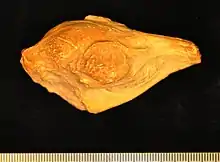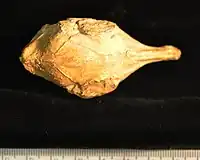| Hypisodus Temporal range: | |
|---|---|
 | |
| Hypisodus retallacki from the Oligocene (Orellan) Cedar Creek Formation in Horsetail Creek, Colorado. | |
| Scientific classification | |
| Domain: | Eukaryota |
| Kingdom: | Animalia |
| Phylum: | Chordata |
| Class: | Mammalia |
| Order: | Artiodactyla |
| Family: | †Hypertragulidae |
| Genus: | †Hypisodus Cope (1873) |

Hypisodus is an extinct genus belonging to the family Hypertragulidae, within the order Artiodactyla, endemic to North America during the Eocene through Oligocene, living 37.2–26.3 Ma, existing for approximately 10.9 million years.[2]
Hypisodus were primitive and ancient ruminants, resembling small deer or musk deer, although they were more closely related to modern chevrotains. Its diet was thought to be that of a frugivore, however it has been noted that its dentition and small body size supports the idea of requiring a highly selective browsing diet resembling other modern small artiodactyls. [3]
Taxonomy
Hypisodus was named by Cope. It was assigned to Hypisodontinae by Matthew and to Hypertragulidae by Cope, Cook and Carroll.[4][5]
Fossil distribution
Partial list of fossil sites:
- 10 N Site, Gallatin County, Montana
- Horsetail Creek, Logan County, Colorado
References
- ↑ Meehan, T.J.; Martin L.D. (2004). "Emended description and a new species of Hypisodus (Artiodactyla: Ruminantia, Hypertragulidae)". New Mexico Museum of Natural History Bulletin. 26: 137–141.
- ↑ PaleoBiology Database: Hypisodus, basic info
- ↑ Lucas, Spencer G. (2004). Paleogene Mammals: Bulletin 26. New Mexico Museum of Natural History and Science. p. 141.
- ↑ W. D. Matthew. 1908. Osteology of Blastomeryx and phylogeny of the American Cervidae. Bulletin of the American Museum of Natural History 24(27):535-562
- ↑ H. J. Cook. 1934. New artiodactyls from the Oligocene and Lower Miocene of Nebraska. American Midland Naturalist 15(2):148–165